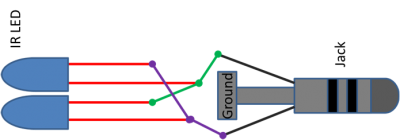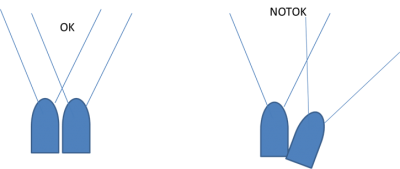Build your own IR transmitter
Contents
Send Factory + 3Speed keys
Other possible methods to send required custom keys are described here: How to send FACTORY+3SPEED keys
Build your own IR transmitter
This page has the goal to show an alternative procedure for sending IR codes to Samsung TV. The procedure has successfully been used for unlocking the Local Area setting available on Service Menu (UE46EH5000) and set the correct one (by sending FACTORY and 3SPEED). In this way I could get a TV 100% compliant to my country (it was bought in another one).
Also tested on several C/D series models, ES8000, for sending INFO+FACTORY and 3SPEED keys for unlocking hidden service menu features.
Theory
The process is based on the fact that the IR key codes are series of square waves at 38kHz of main frequency. The duration in time of the square waves ON and OFF defines the codification of a specific key. By considering a common audio stereo channel (2 mono), it can support max of 22kHz per channel with a total of 44kHz. This means that if an audio stereo channel is created by considering 2 mono channels defined in this way:
- Channel #1= sine wave with 19kHz as main frequency and silent for the time duration at which original IR key square wave is zero
- Channel #2= same as Channel #1 but inverted (basically mirrored)
then, it is possible to emulate the Remote Controller with a simple audio player hardware and a very simple dual led transmitter.
How to build the dual led IR transmitter
Transmitter
This allows you to send IR codes to TV, but you can`t use it to record IR signals from another remote controler (RC). What you need is:
- 2 IR Led 940nm 5mm (the typical one present on RC)
- 1 stereo jack 3.5mm
The connections should be as showed below= Led1 (+) must be connected to Led2 (-) and both to one stereo channel, Led1 (-) must be connected to Led2 (+) and both to the other stereo channel leaving the ground not connected
Using the stereo jack+2Led's and having the needed audio .wav files corresponding to the needed RC key code, it is possible to emulate the RC by inserting the jack in a common .wav player and play the audio files
Transceiver(transmitter/receiver)
If you`re going not only send signals to TV(BD/DVD/HomeTheather/Conditioner/Radio or any other IR controlled device...), but also record your custom IR signals to wav file to PC, you need to build following:
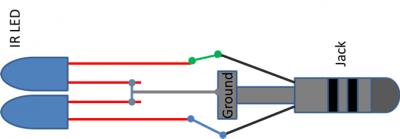
The main difference is that each IR LED`s cathode(-) are connected together and connected to GND (ground), each anode(+) is connected to the stereo channel.
NOTE. To send codes to TV it is enough to build just Transmitter. Just only if you gonna use this tool to replicate IR signals and build custom IR wav`s, you need to build Transceiver.
Ready to use .wav files
Following codes are available:
FACTORY 3SPEED CH UP INFO MENU MUTE POWER ON/OFF
Code combinations - one wav file for specific IR keys sequence:
- Enter to Service menu:
INFO+MENU+MUTE+POWER (from stand by) INFO+FACTORY (from normal mode)
- Service Codes (required to unlock locked service menu settings):
FACTORY+3SPEED
All files in one archive you can download from here.
If you need to create your own wav file (IR code or code sequences), you can use IR Converter - Audacity Plugin, by Gia90.

Important Notes
1. The sound player hardware should have stereo output with enough amplification (I tested on 3 smartphones and it worked only on Nokia N8). It shouldn't be a problem if PC sound card is used
Here is circuit of amplifier, which could be used for smartphones: amplifier for smartphones
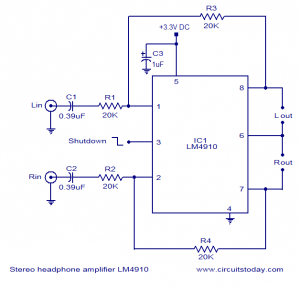
2. The output Volume must be set to maximum level
3. The distance of action (from TV receiver) depends on output amplification (it can be 20cm or 3-4m)
4. The 2 Led must be correctly positioned in order to have enough area where the 38kHz are obtained as sum of the 2x19kHz (see below)
Following some pictures of my IR transmitter based on audio .wav
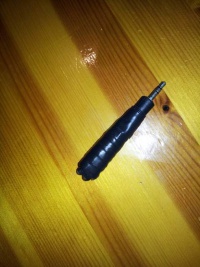
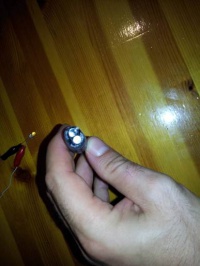
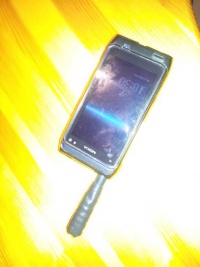
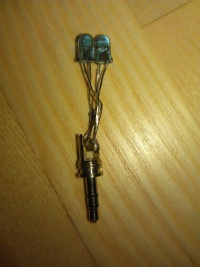
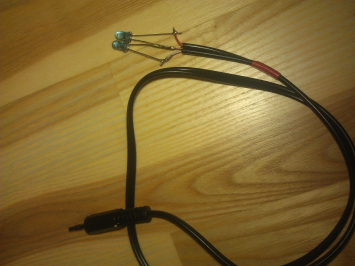
References
- This the link I used as reference for the process [1]
- Related topic on the SamyGO forum.
- http://wgrube-electronics.blogspot.com/2011_08_01_archive.html
--pdca 19:20, 5 July 2012 (UTC)
